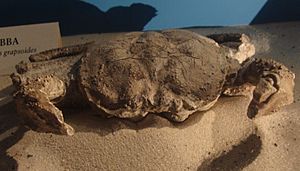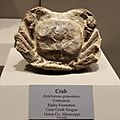Avitelmessus facts for kids
Quick facts for kids Avitelmessus grapsoideus |
|
|---|---|
 |
|
| Scientific classification | |
| Kingdom: | |
| Phylum: | |
| Subphylum: | |
| Class: | |
| Order: | |
| Infraorder: | |
| Family: |
Dakoticancridae
|
| Genus: |
†Avitelmessus
Rathbun, 1923
|
| Species: |
†A. grapsoideus
|
| Binomial name | |
| Avitelmessus grapsoideus Rathbun, 1923
|
|
Avitelmessus grapsoideus was a type of extinct crab. It lived a very long time ago, during the Late Cretaceous period. This means it lived around the time of the dinosaurs! It is the only known species in its group, called Avitelmessus. Scientists have found its fossils in the southeastern part of the United States.
Contents
About this Ancient Crab
How it was Named and Classified
A scientist named Mary J. Rathbun first described Avitelmessus in 1923. She was the one who officially named it. At first, she thought it belonged to a crab family called Atelecyclidae. Later, in 1960, another scientist named Martin Glaessner studied it again. He decided it actually belonged to a different family, the Dakoticancridae.
What it Looked Like
The outer shell of Avitelmessus was about 2.25 inches (5.7 cm) long. It was almost oval-shaped, with smooth, rounded edges. The top of its shell had wide, shallow lines. These lines formed two diamond-like shapes. The larger diamond was closer to the front of the crab.
The front edge of its shell had a small, blunt point in the middle. This point is called a rostrum. There were also eye sockets, called orbits, on each side of the rostrum.
Its front legs were special. They were changed into chelipeds, which are like pincers. These pincers had a top part that could move and a bottom part that stayed still. All of its limbs were covered in tiny bumps, like fine grains.
Scientists have even found one fossil of this crab that still had "color markings"! This is very rare for fossil crabs. The colors were described as a medium background with dark spots and blotches, and some light lines.
Where its Fossils are Found
Mary J. Rathbun first found Avitelmessus fossils in North Carolina. She also found some in Mississippi. Later, she found more fossils in western Tennessee.
Today, we know that Avitelmessus fossils are also found along the Atlantic coastal plain. They are also found in an area called the Mississippi embayment. This area is like a large basin where the Mississippi River once flowed. The fact that these crabs are mostly found in the Mississippi embayment suggests that different types of crabs lived in specific areas.
Images for kids


